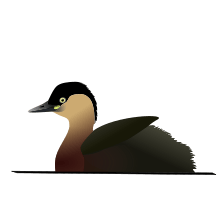Alaotra grebe
| Alaotra grebe | |
|---|---|
 | |
| Scientific classification | |
| Kingdom: | Animalia |
| Phylum: | Chordata |
| Class: | Aves |
| Order: | Podicipediformes |
| Family: | Podicipedidae |
| Genus: | Tachybaptus |
| Species: | † T. rufolavatus |
| Binomial name | |
| Tachybaptus rufolavatus (Delacour, 1932) | |
 | |
| Alaotra grebe range | |
The Alaotra grebe (Tachybaptus rufolavatus), also known as Delacour's little grebe or rusty grebe, is an extinct grebe that was endemic to Lake Alaotra and surrounding lakes in Madagascar.
Description
The grebe was about 25 cm (9.8 in) long.[2] Its ability to fly long distances was restricted because of its small wings.[3]
History
The species declined in the course of the 20th century, mainly because of habitat destruction, entanglement with monofilament gillnets and predation by the introduced blotched snakehead (Channa maculata).[4] Also, the few remaining birds increasingly hybridized with little grebes which use the wetlands as a migration stopover site; as the species differed in several key aspects, the hybrid birds may have suffered from decreased fitness, to the detriment of the rufolavatus gene pool.[5][6]
The Madagascan pochard, which also lived on Lake Alaotra, was thought to be extinct but was rediscovered in 2006.[7] Unlike this species, however, the grebe had poor powers of dispersal and was never found elsewhere.
The last sighting (which may have been a hybrid with the little grebe) was in 1985 and the species was declared extinct in 2010.[8][9] Only one photograph of the species is known to exist.[3][3][9][10] Although some species have been classified as extinct and later have been found to still exist, Leon Bennun, the director of the conservation organization BirdLife International has stated that "no hope remains for this species" and blames the "unforeseen consequences" of human action.[10]
This extinction brought the number of confirmed bird extinctions since 1600 AD to 162. The previous declaration of a bird species as extinct was that of the Liverpool pigeon (Caloenas maculata) in 2008.[3] However, that was more a problem of recognition as that species was last recorded alive in the late 18th or early 19th century.[3]
Gallery
-

The only known photograph of an Alaotra grebe in the wild
See also
- Atitlán grebe, extinct since 1989 for similar reasons
- Endemic birds of Madagascar and western Indian Ocean islands
References
- ↑ BirdLife International (2012). "Tachybaptus rufolavatus". IUCN Red List of Threatened Species. Version 2013.2. International Union for Conservation of Nature. Retrieved 26 November 2013.
- ↑ Endangered Wildlife and Plants of the World. Marshall Cavendish Corporation. 2001. p. 649. ISBN 0-7614-7194-4.
- 1 2 3 4 5 Walker, Matt (26 May 2010). "Bird conservation: Alaotra grebe confirmed extinct". BBC News. Retrieved 26 May 2010.
- ↑ Andrianandrasana, Herizo T.; Randriamahefasoa, Jonah; Durbin, Joanna; Lewis, Richard E.; Ratsimbazafy, Jonah H. (2005). "Participatory ecological monitoring of the Alaotra wetlands in Madagascar". Biodiversity and Conservation. 14 (11): 2757–2774. doi:10.1007/s10531-005-8413-y.
- ↑ Madagascar: Environment Profile
- ↑ Butchart SHM; AJ Stattersfield & TM Brooks (2006). "Going or gone: defining 'Possibly Extinct' species to give a truer picture of recent extinctions" (PDF). Bulletin of the British Ornithologists' Club. 126A: 7–24.
- ↑
- ↑ BirdLife International (2010) Species factsheet: Tachybaptus rufolavatus. Downloaded from "Archived copy". Archived from the original on 2007-07-10. Retrieved 2013-08-07. on 26 May 2010
- 1 2 BirdLife International (2010). Wetland aliens cause bird extinction. Downloaded on 26 May 2010 from http://www.birdlife.org/news/news/2010/05/red-list-for-birds-2010.html
- 1 2 Elliott, Valerie (26 May 2010). "Alaotra grebe declared extinct after struggle against carnivorous fish". The Times. Retrieved 26 May 2010.
